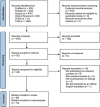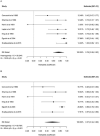Heritability of dental arches and occlusal characteristics: a systematic review and meta-analysis
- PMID: 37822010
- PMCID: PMC10687511
- DOI: 10.1093/ejo/cjad061
Heritability of dental arches and occlusal characteristics: a systematic review and meta-analysis
Abstract
Background and objective: The genetic basis of dentoalveolar characteristics has been investigated by several studies, however, the findings are equivocal. The objective of this systematic review and meta-analysis was to evaluate the heritability of dental arches and occlusal parameters in different stages of human dentition.
Search methods: Electronic databases PubMed, Embase, Scopus, Web of Science, and Dentistry and Oral Science Source were searched up to August 2023 without the restriction of language or publication date.
Selection criteria: Empirical studies investigating the heritability of dentoalveolar parameters among twins and siblings were included in the review.
Data collection and analysis: Study selection, data extraction, and risk of bias assessment were performed independently and in duplicate by two authors and a third author resolved conflicts if needed. Joanna Briggs Institute's critical appraisal tool was used to evaluate the risk of bias among studies and the certainty of evidence was assessed using the Grading of Recommendation, Assessment, Development, and Evaluation (GRADE) criteria.
Results: Twenty-eight studies were included in the systematic review, of which 15 studies reporting heritability coefficients in the permanent dentition stages were deemed suitable for the meta-analysis. Random-effects meta-analyses showed high heritability estimates for maxillary intermolar width (0.52), maxillary intercanine width (0.54), mandibular intermolar width (0.55), mandibular intercanine width (0.55), maxillary arch length (0.76), mandibular arch length (0.57), and palatal depth (0.56). The heritability estimates for the occlusal parameters varied considerably, with relatively moderate values for crossbite (0.46) and overbite (0.44) and low values for buccal segment relationship (0.32), overjet (0.22), and rotation and displacement of teeth (0.16). However, the certainty of evidence for most of the outcomes was low according to the GRADE criteria.
Conclusions: Based on the available evidence, it can be concluded that the dental arch dimensions have a high heritability while the occlusal parameters demonstrate a moderate to low heritability.
Registration: PROSPERO (CRD42022358442).
Keywords: dental arch; dental occlusion; genetics; heritability; malocclusion; siblings; twins.
© The Author(s) 2023. Published by Oxford University Press on behalf of the European Orthodontic Society.
Conflict of interest statement
The authors have no conflicts of interest to declare.
Figures





Similar articles
-
Influence of heritability on occlusal traits: a systematic review of studies in twins.Prog Orthod. 2020 Aug 31;21(1):29. doi: 10.1186/s40510-020-00330-8. Prog Orthod. 2020. PMID: 32864724 Free PMC article.
-
The genetic and environmental contributions to variation in the permanent dental arch form: a twin study.Eur J Orthod. 2023 Nov 30;45(6):868-874. doi: 10.1093/ejo/cjad054. Eur J Orthod. 2023. PMID: 37861389 Free PMC article.
-
Transverse dimensions of dental arches in subjects with Class II malocclusion in the early mixed dentition.Prog Orthod. 2011;12(1):31-7. doi: 10.1016/j.pio.2011.02.006. Epub 2011 Mar 24. Prog Orthod. 2011. PMID: 21515229
-
Is there variation in the depth of the curve of Spee in individuals with different dentoskeletal patterns? A systematic review with meta-analysis.Eur J Orthod. 2022 Sep 19;44(5):491-502. doi: 10.1093/ejo/cjab078. Eur J Orthod. 2022. PMID: 35108382
-
Dental arch width in Class II Division 2 deep-bite malocclusion.Am J Orthod Dentofacial Orthop. 2002 Dec;122(6):608-13. doi: 10.1067/mod.2002.129189. Am J Orthod Dentofacial Orthop. 2002. PMID: 12490871
Cited by
-
Relative contributions of genetic and environmental factors to palatal morphology: a longitudinal twin study.Eur J Orthod. 2024 Dec 4;47(1):cjae076. doi: 10.1093/ejo/cjae076. Eur J Orthod. 2024. PMID: 39704017 Free PMC article.
-
Genetic and environmental contributions to the development of dental arch traits: a longitudinal twin study.Eur J Orthod. 2025 Feb 7;47(2):cjaf018. doi: 10.1093/ejo/cjaf018. Eur J Orthod. 2025. PMID: 40170269 Free PMC article.
-
Genetic and environmental impact on variation in the palatal dimensions in permanent dentition: a twin study.Sci Rep. 2024 Aug 26;14(1):19785. doi: 10.1038/s41598-024-70985-4. Sci Rep. 2024. PMID: 39187685 Free PMC article.
-
Optimizing the power of AI for fracture detection: from blind spots to breakthroughs.Skeletal Radiol. 2025 Oct;54(10):2007-2024. doi: 10.1007/s00256-025-04951-0. Epub 2025 May 23. Skeletal Radiol. 2025. PMID: 40407826 Review.
-
Genetic and environmental contributions to the development of soft tissue facial profile: a twin study.Eur J Orthod. 2024 Oct 1;46(5):cjae045. doi: 10.1093/ejo/cjae045. Eur J Orthod. 2024. PMID: 39271130 Free PMC article.
References
-
- Mossey, P. The heritability of malocclusion: part 2. The influence of genetics in malocclusion. Br J Orthod 1999;26:195–203. - PubMed

